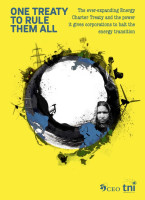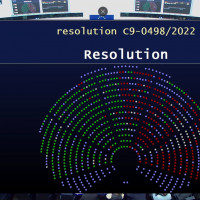The Energy Charter Treaty (ECT) is a huge obstacle for the clean energy transition Demand from European governments to withdraw
Regions
EU national governments will soon discuss the Energy Charter Treaty in the EU Council. Let’s make sure they decide to take us out of this deadly treaty. You can make this happen by sending a message to your decision maker to ensure they exit the Energy Charter Treaty.
The ECT is an international agreement signed in 1994, which applies to more than 50 countries. The ECT gives foreign investors in the energy sector sweeping powers to sue states over government actions that have supposedly ‘damaged’ their investments. Investors use a parallel court system to sue, and the compensation governments have to pay out can be in the billions. The ECT is increasingly controversial – particularly due to its potential to obstruct the transition from climate-wrecking fossil fuels towards renewable energy.
How does the ECT undermine the clean energy transition?
The ECT allows foreign investors in the energy sector to sue governments for decisions that might negatively impact their profits. That includes climate policies, for example German coal giant RWE is suing the Netherlands for €1.4 billion in compensation for the Dutch coal phase-out. UK oil company Rockhopper was recently awarded almost €250 million in compensation because Italy refused them a licence to drill for oil. They were not just compensated for the money they had already invested in explorations but even for potential future profits they would have made selling the oil they never extracted! The ECT’s legal regime – known as Investor-State Dispute Settlement (ISDS) – favours investors, is unpredictable, and the fines that governments can be hit with are catastrophically large. That’s why the treaty acts as a strong incentive to delay, weaken, or drop much needed action to advance the energy transition.
Why is the reform a failure?
Over the past years, members of the ECT have been negotiating changes to the agreement but from the very beginning the scope and ambition was very low. The reform outcomes are very disappointing. Essentially, fossil fuel firms keep their rights to sue countries taking climate action for at least until the mid 2030s; in relation to some fossil gas investments even until 2040. Most controversially, ECT members agreed to even expand investment protection to new technologies such as hydrogen, biomass, carbon capture and storage as well as synthetic fuels. In this briefing, we describe in detail how this increases the risk of future compensation claims, which could cost taxpayers billions and hamper the clean energy transition.
Which countries are at risk?
Many. These are the countries in which the ECT fully applies and so could be sued for taking action to keep fossil fuels in the ground: Afghanistan, Albania, Armenia, Austria, Azerbaijan, Belgium, Bosnia and Herzegovina, Bulgaria, Croatia, Cyprus, Czech Republic, Denmark, Estonia, Finland, France, Georgia, Germany, Greece, Hungary, Iceland, Ireland, Japan, Jordan, Kazakhstan, Kyrgyzstan, Latvia, Liechtenstein, Lithuania, Luxembourg, Macedonia, Malta, Moldova, Mongolia, Montenegro, The Netherlands, Poland, Portugal, Romania, Slovakia, Slovenia, Spain, Sweden, Switzerland, Tajikistan, Turkey, Turkmenistan, Ukraine, United Kingdom, Uzbekistan, and Yemen. As a separate ECT member the EU can also be sued as a whole – NordStream2 AG has an ongoing compensation claim against the EU.
What about the expansion to even more countries?
The Brussels-based Secretariat of the ECT – the driving force behind drumming up both support and new signatories for the treaty – is putting great effort into expanding the geographical reach of the agreement to countries in Africa and the Middle East, Asia, and Latin America. The Secretariat downplays the risks of the ECT and exaggerates its benefits. As a result, many countries are in line to sign the agreement, with its extreme investor privileges (see this excellent briefing by TNI to find out more). In signing up, they risk shrinking their ability to decide their own energy policy, as well as opening themselves up to the potential for costly lawsuits by investors. We need to stop this dangerous expansion of the ECT.
How can countries get out of the ECT?
Withdrawing from the ECT is not difficult. As soon as a country has been a member for five years, it can leave the ECT at any time by simply giving written notification. They could withdraw from the ECT immediately; Italy did just that in 2016 and Poland, Germany and France handed in their withdrawal notice in December 2022, which means their withdrawal will take effect after one year at the end of 2023. A joint withdrawal of all remaining EU member states and other non-EU members of the ECT would have an even greater positive impact as they could neutralise the so-called ‘sunset clause’, which kicks in when a state leaves. The sunset clause says that a country can be sued for another 20 years after it has left the ECT, which is outrageous. However, if countries withdraw jointly, they can close an additional agreement saying that the sunset clause doesn’t apply in relation to one another (see this legal blog for details). This would greatly reduce the risk of being sued in future.
What’s the role of the EU?
Together with member states like the Netherlands and the UK, the EU was the driving force behind the ECT negotiations in the 1990s. They wanted to protect the investments of fossil fuel companies like Shell and BP in post-Soviet bloc countries. But today, EU member states are at the receiving end of costly claims and the ECT threatens to undermine the European Green Deal and the EU’s climate law. Having started the ECT mess, the EU has the responsibility for cleaning it up – for the sake of a world that needs to decarbonise rapidly.
Where can I find more information?
Further information in our policy briefing
Why ECT reform doesn’t solve the problem: CAN Europe reform briefing




